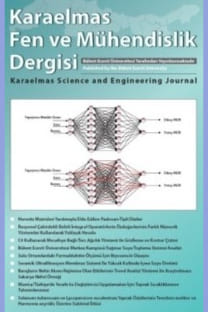Ticari Olarak Kullanılan İki Çeşit Magnezya ve Spinel Refrakter Hammaddelerindeki Safsızlıkların Faz ve Mikroyapı Karakterizasyon Çalışmaları
Magnezya ve spinel hammaddelerindeki mineralojik safsızlıklar, magnezya-spinel refrakterlerdeki; örneğin eriyik/cüruf direnci, fiziksel ve termo-mekanik gibi farklı özellikleri etkileyen en önemli parametrelerden biridir. Yapılan bu çalışmada, ticari olarak kullanılan iki çeşit fused/sinter magnezya ve spinel hammaddeleri, safsızlıkların karakterizasyonuna ağırlık verilerek mikroyapı ve faz kompozisyonu açısından incelenmiştir. X-ışınları kırınımı tekniği ile faz analizi, taramalı elektron mikroskobu ve geri yansıyan elektron difraksiyonu tekniği ile mikroyapılar incelenmiştir. Her iki spinele yapılan X-ışınları kırınımı tekniği; ana fazların MA-spinel olduğu ve herhangi bir safsızlığın tespit edilmediğini göstermektedir. Sinter magnezyaya yapılan EBSD analiz sonucu, ana fazın periklas, tane sınırlarında ise mervinit ve montisellit fazlarının olduğunu açığa çıkarmıştır. Buna karşın, fused magnezyada tane ve tane sınırlarındaki faz kompozisyonlarının çok benzer olduğu, periklas, mervinit ve dağılmış durumda montisellit fazının olduğu karakterize edilmiştir
Anahtar Kelimeler:
Karakterizasyon, Magnezya, Mikroyapı, Faz miktarları, Bazik refrakterler, Spinel
Phase and Microstructural Studies of Two Types Commercial Magnesia and Spinel Refractory Raw Materials with Emphasis on Impurities Characterization
Mineralogical impurities of the used magnesia and spinel raw materials are kinds of most important factors which strongly effect on different properties of magnesia-spinel refractories such as melt/slag resistance, physical and thermo mechanical behavior. In this research, two types of commercially available fused/sintered magnesia and spinel raw materials were investigated in terms of microstructure and phase composition with emphasis on the impurities characterization. The phase analysis was studied via X-ray diffraction and the microstructure was investigated using scanning electron microscopy and electron back scattered diffraction techniques. X-ray patterns showed that the main phase in both spinels is MA spinel and any other impurity phases are not detected. The EBSD results revealed that the major phase of sintered magnesia is periclase and the grain boundaries were characterized as merwinite and monticellite. In contrast, for fused one, it is found that the phase composition of grains and boundaries are very similar and were characterized as periclase, merwenite and dispersed monticellite.
Keywords:
Magnesia, spinel, refractories, microstructure, phase evolution, EBSD characterization,
___
- Abadi, E.A.M.H., Golestani, F., and Moztarzadeh, F. 2001. Evaluation of the microstructure of magnesia-zirconia refractories. Ind. Ceram., 22[1]: 19-25.
- Alvarado, E., Martinez, M.L., Fuentes, A.F. and Quintana, P. 2000. Preparation and characterization of MgO powders obtained from different magnesium salts and the mineral dolomite, Polyhedron, 19: 2345-2351.
- Bilgiç, M. 2001. Future of Magnesia and Steelmaking Refractories. TMMO Metallurgy J. 127: 43-48.
- Bhatti, AS., Dollimore, D., Dyer, A. 1984. Magnesia from seawater: a review. Clay Min., 19: 865-875.
- Braulio, M.A.L., Bittencourt, L.R.M. and Pandolfelli, V.C. 2008. Magnesia grain size effect on in situ spinel refractory castables. J. Eur. Ceramic Soc., 28: 2845-2852.
- Erdoğan, N, Yıldız, R. 1995. Magnesite and Basic Refractory Material Technology, Lale Publication, Kütahya, 43-44 s.
- Hamzaçebi, C. 1991. The Effectes of Process Parameters on the Properties of Spinel Refractories, Master of Science Thesis, Istanbul Technical University, 6-8 s.
- Han, B., Li, Y., Guo, C., Li, N., Chen, F. 2007. Sintering of MgO-based refractories with added WO3. Ceramics Int., 33: 1563-1567.
- Kingery, WD., Bowen, HK., Uhlmann, DR. 1975. Introduction to ceramics, Wiley-InterScience Publication, New York, USA, pp. 61.
- Maryasev, G., Koptelov, VN., Kaplan, SF., Koreshkova, MY. 2003. Effect of precursor raw materials on the structure of fused alumina magnesia spinel. Refrac. Ind. Ceram., 44: 405- 410.
- Rodríguez, E., Moreno, F.H., Aguilar-Martínez, J.A., MontesMejía, A.E., Ruiz-Valdés, J.J., Puente-Ornelas, R. and Contreras, J.E. 2016. Effect of nano-titania (η-TiO2 ) content on the mechano-physical properties of a magnesia refractory composite. Ceramics Int., 42: 8445-8452.
- Ünal, D. 2010. Determination Texture Fraction in Fe-doped Alumina Substrates Used for Production of Carbon. Master of Sciences Thesis, Anadolu University, 6 s.
- ISSN: 2146-4987
- Yayın Aralığı: Yılda 2 Sayı
- Başlangıç: 2011
- Yayıncı: ZONGULDAK BÜLENT ECEVİT ÜNİVERSİTESİ
Sayıdaki Diğer Makaleler
An Investigation on the Quality of Natural Spring Waters in Zonguldak Province (Turkey)
Hüseyin AYTEKİN, Nazmi BAYRAKTAROĞLU
MAG-TIG- Tozaltı Kaynak Bağlantısının Sonlu Elemanlar Yöntemi İle Termal Analizi
SERKAN SEZEN, ERCÜMENT KARAKAŞ, KADİR YILMAZ
Dolgu Duvarlı Betonarme Çerçeveli Binalarda Hakim Periyodun Belirlenmesi
Doğal ve Yapay Liflerden Üretilen Panellerin Yalıtım Özelliklerinin Araştırılması
